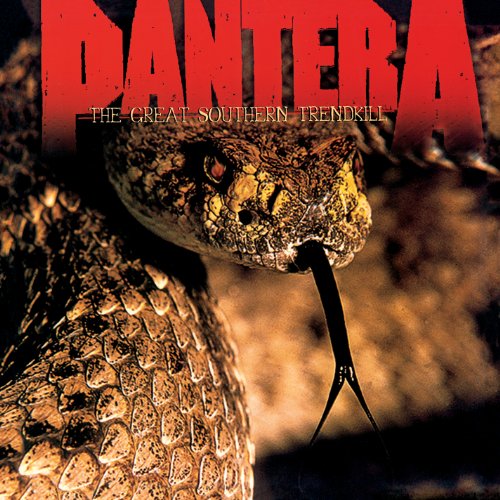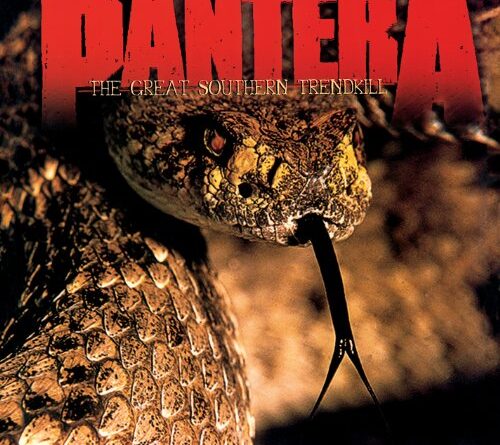HEAVY MUSIC HISTORY: The Great Southern Trendkill – Pantera
It’s 1996. PANTERA have reached the heights any metal band could ever dream of. Their last record, Far Beyond Driven, reached number one on the Billboard charts and the band are playing arenas on a regular basis. This is truly the goal that every band sets out to accomplish, and yet PANTERA are tearing at the seams and standing on a knife’s edge. Lead singer Phil Anselmo‘s chronic back pain has caused him to spiral down a road of heroin addiction and erratic and violent behaviour; often lashing out at his brothers in arms Dimebag Darrell, Vinne Paul, and Rex Brown, and causing fissures within a band that once felt indestructible and rock solid in their camaraderie.
But there’s that little saying about the hardest steel being forged in the hottest fire. What emerged from this, the hottest fire of PANTERA‘s career, was The Great Southern Trendkill, an album that took the sledgehammer heaviness of Far Beyond Driven and turned it into a ragged and rusted axe. It, more than any other record in the band’s career, encapsulates pure anguish and lays bare the agonizing strife that Anselmo was dealing with behind the scenes. This, the so called “forgotten” record of PANTERA, is a remarkable album in the way that its sound is the aural embodiment of a man desperately struggling to free himself from the filth and grime of a Louisiana swamp in 110 degree heat. The audience can hear this, and feel this, and though it’s not a concept record in the traditional sense, it tells a story as dark and compelling as any in metal, and it proved to be the beginning of the end for the juggernaut that was PANTERA.
The record itself was recorded when tensions were already at an all time high in the band. Anselmo recorded his vocals separately in New Orleans while the rest of the band had laid out the instrumentals in Dallas. They simply could not endure that long of a process together, with Anselmo‘s drug use at its peak and the behaviour that followed it nigh unbearable for his bandmates. With no one around, it’s evident that Anselmo used his time to let loose a rage that had been channelled and focused on the previous record, but now was unhinged and explosive. Right from the first notes of the opening title track, he is set to destroy. Spewing pure vomit against the magazines and MTV that seize upon personal drama, while from the first lines admitting he is at his own wit’s end and is about to break apart. The end is near, and through all of this Dimebag is delivering his swampiest and sleaziest licks and riffs to date. His guitar whines and squeals like a pig to the slaughter, and even the mix on the low end that Vinne Paul and Rex Brown are delivering sound scratched with sandpaper rather than the hammer on nails of Far Beyond Driven. The beats are furious and exude the panic of a man (and a band) trapped.
When the next song, War Nerve, starts with the line “Truly, fuck the world,” the focus only becomes more clear of just how much suffering Anselmo was dealing with during this record, but its importance lies in the songs that emerged. This is some of his strongest song writing, with lyrics across the record only matched by his truly maniacal screams that are pulled from a place very few people ever want to reach. This song is pure desperation, as are songs like 10s and Living Through Me (Hell’s Wrath). With the first being a slow, sweating fever reaching into destruction of the body, the latter backed by one of the most underrated and furious Dimebag riffs of PANTERA‘s career, which sees Anselmo seemingly revelling in his own destruction, while simultaneously observing the chaotic and dark choices of his life. It’s incredibly dark street poetry that goes further in painting a true picture of rock bottom than most records have attempted, and the natural extension of themes that Far Beyond Driven only began to scrape.
These two songs also represent another dimension the record evolved on over its predecessor, and that is the use of dynamics to tell a story. The musical divergence between 10s and Living Through Me (Hell’s Wrath) is only the beginning. There is no better use of dynamics in the band’s history (except for perhaps Cemetery Gates) than Suicide Note Pts 1 and 2. These two tracks, both lyrically and musically, are perhaps the most haunting of the bands entire discography. The warbled, backwards tone of the opening of part 1, leading to the spine tingling acoustic guitar riff and Anselmo‘s opening verse rank as the most heart-breaking musical moment of the band’s career, far and away.
The sadness and loneliness of this track are captured through its immaculate melodic construction, lulling the listener into the sweet release of death, before launching them into the pure hellfire of part 2, one of the heaviest songs of the band’s career, and certainly on this album. It is an all out aural assault without breaking into all out chaos. It’s a stomper that reflects the other side of the suicide: the violence, the panic, the pure anguish. The ending is pure brutishness and brutality, with Anselmo‘s gutturals going as low as they ever have and Dimebag revving his guitar like a circular saw cutting through bone while the vocals scream bloody murder. Vinnie and Rex and slamming like a pickaxe to the head. It’s gone from letting a dirty life slip away to all blood and guts. And it’s a remarkable evolution for the band, borne out of the darkness between and within.
The final evolution and impact this album truly has is in its musicianship. It’s faster, thrashier, more chaotic. But within that chaos lies some very cool experimentation. The industrial sounds found on Living Through Me are totally unique, as is the Suicide Note opening. But where the real gold lies is in Dimebag‘s guitar work and how it worked to create a musical story as opposed to just a catalogue of amazing riffs and solos. From the discordant plinking of Floods‘ guitar opening to its virtuosic solo, and to the pure swampy sleaze and whine of Drag The Waters, to the grungy chug of The Underground In America and the thrash, pick scrapes, and low end of (Reprise) Sandblasted Skin, these are some of his most creative riffs and guitar parts of any PANTERA record, and stand apart in the way they feel absolutely perfect to narrate just as powerful a story of utter self destruction as any of Anselmo‘s vocals and lyrics.
It’s criminal how overlooked the riffs on this record are, but more than that are just how impactful these guitar parts are in the context of forming a narrative. Just the same, Vinnie Paul and Rex Brown also do a hell of a job adding rhythms and deep tones to bring what is low already lower. Theirs is the pulse and pound of the pistons at the sawmill while Dimebag is the saw, cutting through a man at the end of his rope. This album is, quite simply, the darkest and the most impactful piece of musical art the band would ever produce.
And yet it would not save them. PANTERA would never recover from the darkness. Though they would go on to record one more record in 2000’s Reinventing The Steel, the wedge had been driven so firmly in between Anselmo and the rest of the band that the band was never truly the same with each other. Following Anselmo‘s near death heroin overdose that shortly followed the release of The Great Southern Trendkill and the beginning of his dabbling with a myriad of side projects including DOWN, the rest of the band never quite knew how to make it work in the long term with their lead singer. And the story that follows will always be just as tragic, just as heart-breaking as it always is; a life cut far short, and the vitriol and he-said-she-said that followed, and continued until another tragic death, as the Abbott brothers and Anselmo never healed together.
But The Great Southern Trendkill is a record that proves that in the throes of pain and distance, both personal and interpersonal, something can be created that can never be replicated. It’s one of only a handful of records that capture mental and physical darkness in a way so crystallised, that every song feels exactly in the place it needs to be, and every vocal and instrument is where it should be. The album is a lyrical snapshot in time of the slow poison that plagues so many who are suffering with addiction, and is incredibly resonant to this day. But the guitar work on this record is a showcase of talent from Dimebag Darrell that arguably exceeds any other PANTERA record. It’s his creativity under a pressure cooker that created some of the most creative and twisted riffs of his career, and backed by an equally talented rhythm section. The record is truly great because it is a window into the pitch black darkness, and one from which the band never truly emerged from. But from which they crafted the experience of what it was like for the rest of us.

The Great Southern Trendkill was originally released May 7th 1996 via East West Records.
Like PANTERA on Facebook.

